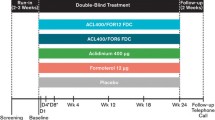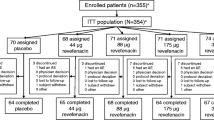Abstract
An open multicenter trial was performed in 242 subjects with chronic obstructive airways disease between August 1987 and April 1989. Two hundred thirty-six subjects were evaluated with regard to safety (m 137, f 99, mean age 49.4 (18–77) years) and 204 subjects with regard to therapeutic efficacy (m 120, f 84, mean age 49.2 (18–77) years). Twelve micrograms (one puff) formoterol was given by metered-dose inhaler twice daily. Investigations were performed at days 0, 14, and subsequently in monthly intervals. Twenty-one patients (10.3%) were sufficiently treated by formoterol alone. One hundred and eighty-three (89.7%) required additional medication, which could be reduced in 90 cases (45.6%). Initially symptoms were present in 201 of 204 patients. At 1 year, 43 patients (21.1%) were symptom-free. At day 0 32.4% of the patients felt “very good” or “good.” At 1 year the rate increased to 68.1%. Raw decreased from 0.52 ± 0.26 (0.06–2.11) kPa·L−1·s at day 0 to 0.33 ± 0.14 (0.06–0.88) kPa·L−1·s (= −43.5%) at 1 year. FEV1 increased from 1.90 ± 0.80 to 2.54 ± 0.97 L (33.7%). The global assessment of therapeutic efficacy was classified as “very good” in 51% (patients) and 47% (doctors), respectively, and as “good” in 38.7% and 42.0%, respectively. Tolerability was “very good” in 82.3% (patients, doctors), and “good” in 12.7% (patients) or 13.7% (doctors). The treatment did not influence blood pressure or heart rate. Twenty-nine patients (12.3% of 236) reported unwanted 39 side effects, such as tremor (6.36%), headache (2.54%), dryness of the mouth (1.27%), cough (0.85%), and dizziness (0.85%). Thirty-two patients discontinued treatment before the end of the trial. In 15 cases (6.4%) this was related to the drug (unwanted side effects, 7 cases; insufficient therapeutic efficacy, 8 cases). 170 patients (83.3% of 204) preferred formoterol to their prior bronchodilator medication (“better”), 21 (10.3%) thought it to be “equal,” and 9 (4.4%) “worse” (4 cases without statement). Clinical efficacy of formoterol, together with the low rate of unwanted side effects, indicate that this drug might be a major step forward in the therapy of chronic reversible airway disease, exceeding the therapeutic efficacy of theβ 2-agonists available to date.
Similar content being viewed by others
References
Berg AV, Berdel D (1989) Wirkungsprofil von Formoterol bei Kindern. In: Nolte D, Burghele A (eds) Bronchospasmolyse mit Beta-2-Sympathikomimetika. Dustri-Verlag, München-Deisenhofen (1989), pp 83–107
Kerrebijn KF, van Essen-Zandvliet EE, Neijens HJ (1987) Effect of long-term treatment with inhaled corticosteroids and beta-agonists on the bronchial responsiveness in children with asthma. J Allergy Clin Immunol 79:653–659
Kerrebijn KF, Raes MMR (1988) Effect of longterm administration of anticholinergic or beta-agonist on bronchial hyperresponsiveness in children (Abstract). Am Rev Respir Dis 137:25S
Kraan J, Koeter GH, van der Mark TW, Sluiter HJ, de Vries K (1985) Changes in bronchial hyperreactivity induced by 4 weeks of treatment with antiasthmatic drugs in patients with allergic asthma: a comparison between budesonide and terbutaline. J Allergy Clin Immunol 76:628–636
Löfdahl CG, Svedmyr N (1986) Effect duration of inhaled formoterol, a newβ 2-adrenoceptor agonist, compared to salbutamol in asthmatic patients (Abstract). International Congress of Pharmacol. Stockholm
Löfdahl CG, Svedmyr N (1988) Inhaled formoterol, a newβ 2-adrenoceptor agonist, compared to salbutamol in asthmatic patients (Abstract). Am Rev Respir Dis 137:330
Löfdahl CG, Arvidsson P, Melander B, Svedmyr N, Wahlander L, Larsson S (1988) Longer duration of formoterol, a newβ 2-adrenoceptor agonist, compared to salbutamol in a 2 week trial in asthmatic patients. Huber, Bern pp 32–37
Magnussen H, Kanzow G, Reuss G, Jörres R (1988) Die bronchodilatatorische Wirkung von Formoterol im Vergleich zu Fenoterol-Dosier-Aerosol bei Patienten mit Asthma bronchiale. Atemw-Lungerkrkh 14:S112-S115
Nolte D, Meyer PW (1988) Ergebnisse einer Dosisfindungsstudie mit Formoterol als Dosier-Aerosol. Atemw-Lungenkrkh 14:S105-S107
Schultze-Werninghaus G (1989) Formoterol—ein neuer inhalativer Beta-2-Adrenozeptor-Agonist mit langer Wirkdauer zur Therapie obstruktiver Atemwegserkrankungen. In: Nolte D, Burghele A (eds) Bronchospasmolyse mit Beta-2-Sympathikometika. Dustri-Verlag, Munich-Deisenhofen, pp 34–58 and Open multicentre study of formoterol, a new long-actingβ 2-agonist: interim report covering the first three months. (1989) Hogrefe and Huber, Lewiston and Toronto, pp 37–42
Author information
Authors and Affiliations
Rights and permissions
About this article
Cite this article
Schultze-Werninghaus, G. Multicenter 1-year trial on formoterol, a new long-actingβ 2-agonist, in chronic obstructive airway disease. Lung 168 (Suppl 1), 83–89 (1990). https://doi.org/10.1007/BF02718118
Issue Date:
DOI: https://doi.org/10.1007/BF02718118




